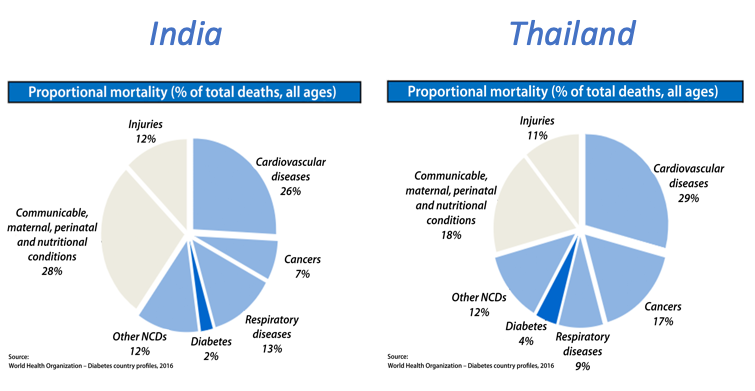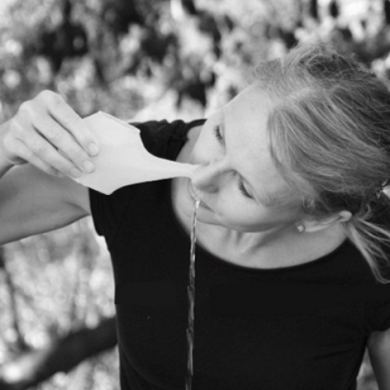
Yoga – an ancient remedy and protection from inhaling polluted air
Every human society nowadays, be it rural or urban, industrial or technologically developed, is affected by polluted air (through dust, fumes and chemicals). Worldwide we experience an increase of polluted air in the last decade which leads to severe respiratory ailments like:
• Asthma, a chronic disease with recurrent attacks of breathlessness and wheeze.
• COPD = Chronic Obstructive Pulmonary Disease, (better known as Chronic Bronchitis and Emphysema) makes it hard to breathe and usually accompanied by a long-term cough with mucus.
• Pulmonary Hypertension, a condition in which there is high blood pressure in the lung arteries. The lung arteries become narrow and there is less room for the blood and energy to flow.
• Allergic Rhinitis or hay fever happens with breathing in something to which you are allergic. The inside of your nose becomes inflamed and swollen.
• Sinusitis, an inflammation of the sinuses. Sinuses are small, air-filled cavities behind the cheekbones and forehead. When sinuses become blocked, they get inflamed and make breathing difficult.
• Obstructive Sleep Apnea Syndrome marked by frequent pauses in breathing during sleep usually accompanied by loud snoring. These pauses are dangerous as they may cut off the oxygen supply to your body for seconds.
Millions of people suffer every day from chronic respiratory diseases. According to the latest WHO Global Asthma Report (2018), currently 339 million people have asthma, 251 million people have

Symptoms of pollution in the respiratory system are…
• Shortness of breath
• Tiredness
• Headache
• Asthma and breathing problems
• Cough and congestion
• Sinuses
But how can we as individuals protect us from respiratory ailments due to polluted air? We cannot stay the whole time indoors. We still have to go out and inhale air. Practices which do not raise the respiratory rate and yet help to increase oxygen levels in the blood, remove toxins (carbon dioxide) from the lungs, provide relaxation techniques to control our mind and emotions and allow to breathe easier, are necessary. Yoga is a group of physical, mental, and spiritual practices and disciplines which originated in ancient India and is the only system eminently meeting all these requirements. Yoga provides us with good health, wellbeing and a strong immunity against pollution.
Regular yoga practitioners, especially the ones who do daily pranayama (breathing practices) are comparably more protected from respiratory diseases and will maintain their healthy respiratory system than people who do not at all, or do less yoga and pranayama. The majority of the yoga practitioners still believe and practice yoga mainly as a physical exercise. Of course, there are asanas (yoga postures) which move the spine in all directions, expanding the lungs, giving them space to breathe, stretching and strengthen the muscles around your upper body. All these asanas are great and will help to support your respiratory system and enhance airflow. Through sweating, some toxins come out as well but not all. The best way to remove toxins from your body and the respiratory system is through pranayama.
How does pranayama work?
Pranayama is an amazing technique to purify your respiratory system. When you learn to breathe correctly, you get a rich supply of oxygen to your body and at the same
Generally, people breathe out 13-15 breath per minute or even more. But those who practice yoga and in particular pranayama can reduce their breathing speed 6-7 breath per minute, or even less. Due to more pollutants in the air, breathing becomes more difficult, thus faster and shallow. Toxins stay in the lungs and the volume of toxin deposits in the body raises up. When you decrease your carbon dioxide level in your body, through effective breathing, your breathing can become slow and naturally, you feel calm, quiet and peaceful.
Four yoga practices are helpful to keep your respiratory system healthy
1) Practice Kapalabhati (forceful exhalation breath) a breathing technique that cleanses and detoxifies your lungs and forehead (sinuses). To make it more effective, use the abdominal muscles. With
Precaution: People with high blood pressure, reactive quick temper, heart problems, acidity, ulcer, hyperthyroid and post-surgery patients must refrain from this practice.

2) Practice Nadi Shodana (alternate nostril breathing). This is the most effective and important yoga practice among all. The whole purpose of yoga is to perfect this practice. To perfect means to make our breathing slow, smooth, rhythmic and long. This practice also recharges each and every cell including the brain cells. It cleans our nerve passages as well. ‘Nadi’ means nerves through which prana and the blood flow and ‘Shoda’ means cleaning. It works like a vacuum cleaner, cleans our nerve passages and removes blockages from our bloodstream and heart. This practice is not only instant but also has long-term effects. Through this
Sit upright and close your eyes. Place your right index and middle fingers at your eyebrow centre and cover your right nostril with your right thumb. Inhale slowly and deeply without force only through the left nostril. Cover the left nostril with your ring finger and pause for a second. Release the right nostril and exhale slowly and completely through the right nostril. Cover the right nostril, pause for a second, then release the left nostril and exhale slowly and completely. This constitutes one complete breath. Practice for 5 to 10 minutes in the morning prior to breakfast or before going to bed but not right after meals.
Precaution: There is no precaution. Everyone can do this practice even if you have some other health issues.

3) Every day before going to bed do abdominal breathing long and deep with the help of your abdominal muscles to improve your lungs capacity for better respiration. Remember in general nasal breathing is always healthier than mouth breathing.

4) Neti (nasal cleansing), is one of the six Hatha yogic purification techniques, which are essential in maintaining a healthy body and mind. For Neti you need a special neti pot. Use lukewarm saline water to clean the nasal passage and the sinus cavity to prevent viral infections and to help cure chronic sinus problems. This practice has instant benefits. It is very effective for people who suffer from allergies, stuffy nose, sinusitis, and asthma. It not only cleans your facial muscles and gives your face a glowing and radiant skin
by Sanjiv Chaturvedi, Co-founder and Director of Divine Yoga www.divine-yoga.com
read more articles about Yoga here: http://divine-yoga.com/yogaarticles.html



